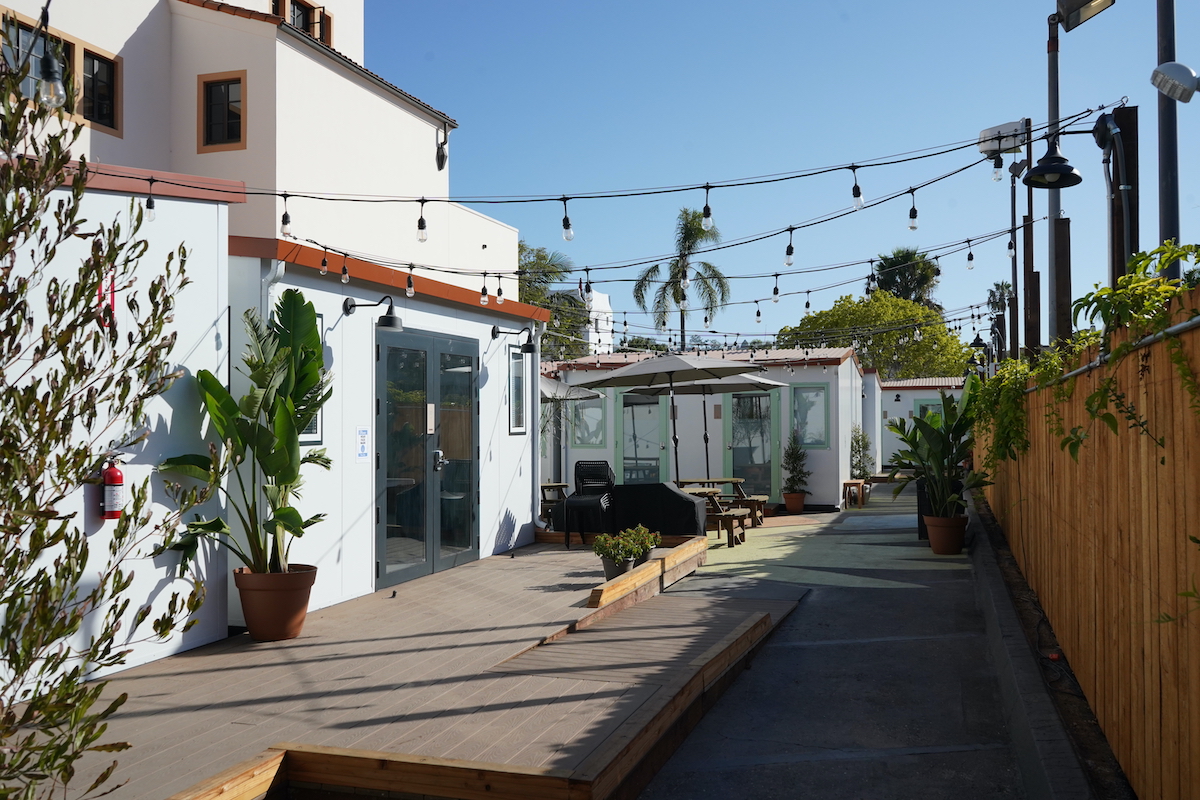Tiny Houses Open Doors to Santa Barbara Homeless Guests
DignityMoves Begins Moving Residents off Streets and into Groundbreaking New Project

After hosting three gala ribbon-cutting events since last November, DignityMoves finally began admitting the first homeless clients into its groundbreaking new tiny-home village located at 1016 Santa Barbara Street early this Monday, August 8. As openings go, this one was softer than cats’ paws.
As of day one, six residents had been moved off the streets or out of vehicles and into what’s alternately described as “cabins,” “tiny homes,” or, more bureaucratically, “interim supportive housing.” Whatever one chooses to call this tightly packed, intensely designed community of prefabricated homes — each one 64 square feet with windows, a bed, a chair, a desk, heating and air conditioning, and a door that locks — it ranks as Santa Barbara’s boldest effort to address the needs of Santa Barbara’s chronically homeless people. Each day for the next two weeks, a handful of new residents will move in. When there are 35, capacity will have been achieved.
“Nothing like this has been tried here before,” said Jeff Gaddes, project manager. That, if anything, is an understatement. Never before has such a concentration of homeless housing and services been placed in the heart of downtown Santa Barbara. The project’s immediate next-door neighbor is the investment firm of Morgan Stanley. The police station is half a block away, with the Santa Barbara District Attorney’s annex and the fabled courthouse almost spitting distance.

Gaddes — who brings relevant work experience in the mental-health field and the concierge hotel industry — works for Good Samaritan, the Santa Maria–based social justice nonprofit. The County of Santa Barbara contracted that group to make sure the new community is well-run. It will provide the services needed for residents to transition to long-term housing and will work to prevent the neighbors from being disturbed.
The first night, Gaddes said, was both exciting and moving. With a full moon in the sky and the courthouse tower looming, he said, the whole thing felt magically real and unreal at the same time.
The slow move-in is part of the plan to allow people accustomed to living in perpetual fight-or-flight mode to adjust to living within four walls and having three meals and clean bathrooms. “These are people who’ve been in survival mode,” Gaddes said. “Their level of exhaustion is extreme, both physically and emotionally. They just need time to rest.” There will be weekly visits from medical professionals working for Doctors Without Walls and from County Public Health, as well as Behavioral Health. Private security will be onsite 24/7, not to mention staffing by Good Samaritan.
Sign up for Indy Today to receive fresh news from Independent.com, in your inbox, every morning.
And there are rules. Curfew is at 9 p.m. No loitering or hanging around out front. No friends can hang around either. Drinking and drugs are not allowed. Nothing, as Gaddes explained, is to disrupt the peace and recovery of the residents who will receive “enhanced case management.” Translated, Gaddes said, that means “understanding why a person is on the streets; it means giving them the space to tell their story.”
Three of the first six people are women. The new residents ranged in age from their late twenties to their seventies. Many have been on the streets a very long time, some for decades. Several are well-known and immediately recognizable to people who walk on State Street with any regularity. Recruiting residents is not as easy as it may seem; trust has to be earned, a process that can take months of almost daily conversations.

The project was sparked by a conversation that Terri Maus-Nisich, a high-ranking county administrator, had with a Santa Barbara resident who was describing the work of a Bay Area nonprofit known as DignityMoves. It was supported by younger entrepreneurs dedicated to getting people off the streets and into transitional housing. From that conversation, a $1.7 million construction proposal was made to the county, which agreed to kick in $700,000 of emergency federal funding made available during the pandemic. It also contributed the land, which until recently was a public parking lot operated for the benefit of the county Probation Department. The county set aside another $1.2 million a year — for three years — to cover Good Samaritan’s costs for services, management, and administration.
The hope is that this new community will provide temporary housing to 66 people a year — or 200 over three years. That pencils out to roughly $25,000 per person.
Initially, the opening was slated to take place early this year. Then it got pushed back to June because the prefabricated structures were stuck in shipping containers stuck on cargo boats stuck in the Long Beach Harbor. Then there was a snafu with Southern California Edison that pushed back the June opening until August. For Gaddes, it’s showtime. Downtown residents will feel the difference, he said: “You’ll see people off the streets. In six months, here’s what I hope the story will be: ‘I forgot it was even there.’”
Support the Santa Barbara Independent through a long-term or a single contribution.




You must be logged in to post a comment.